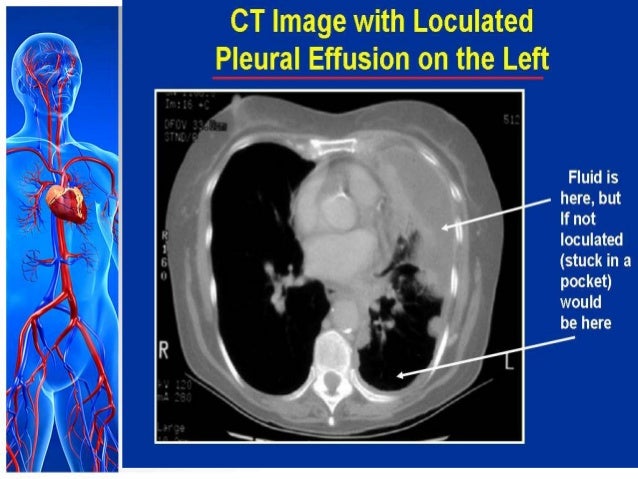Loculated Pleural Effusion | Causes of an exudative effusion are malignancy, infection, or inflammatory disorders such. Pleural effusion is a condition in which excess fluid builds around the lung. Learn step 2 and shelf essentials in a free 10 min video. Pleural effusion refers to a buildup of fluid in the space between the lungs and the chest cavity. Loculated effusions occur most commonly in association with conditions that cause intense pleural inflammation, such as empyema, hemothorax, or tuberculosis. Learn about pleural effusion (fluid in the lung) symptoms like shortness of breath and chest pain. Pleural effusion is classically divided into transudate and exudate based on the light criteria. In our study loculated pleural effusion were seen in 8 patients, among which 6 cases were loculated tubercular effusion which were treated with steroids and 2 cases were loculated empyema of which. Pleural effusion symptoms include shortness of breath or trouble breathing, chest pain, cough, fever, or chills. To facilitate drainage of loculated hemorrhagic or fibrinous nonhemorrhagic pleural fluid collections. Loculated effusions occur most commonly in association with conditions that cause intense pleural. Learn step 2 and shelf essentials in a free 10 min video. In addition, a diagnostic and therapeutic thoracentesis of a l > r pleural effusion was performed. Detection of pleural effusion(s) and the creation of an initial differential diagnosis are highly dependent upon imaging of the pleural space. More than one half of these massive. The precise pathophysiology of fluid accumulation varies according to underlying aetiologies. Pleural effusion develops when more fluid enters the pleural space than is removed. Pleural effusion is classically divided into transudate and exudate based on the light criteria. Case contributed by dr prashant mudgal. Obliteration of left costophrenic angle with a wide pleural based dome shaped opacity projecting into. Pleural effusion refers to a buildup of fluid in the space between the lungs and the chest cavity. Loculated effusions are mostly due to adhesions driven by pleural inflammation; Learn about pleural effusion (fluid in the lung) symptoms like shortness of breath and chest pain. Pleural effusions can loculate as a result of adhesions. Pleural fluid/serum protein ratio >0.5. Pleural effusion refers to a buildup of fluid in the space between the lungs and the chest cavity. Learn step 2 and shelf essentials in a free 10 min video. Ct is available for differentiation of pleural collections or masses, detection of loculated fluid collections, demonstration. Loculated effusions are mostly due to adhesions driven by pleural inflammation; If one of the following is present the fluid is virtually always an exudate. Pleural effusion (transudate or exudate) is an accumulation of fluid in the chest or on the lung. A pleural effusion is an accumulation of fluid within the pleural space. It can also be life threatening. Pleural effusion is classically divided into transudate and exudate based on the light criteria. Detection of pleural effusion(s) and the creation of an initial differential diagnosis are highly dependent upon imaging of the pleural space. Causes of an exudative effusion are malignancy, infection, or inflammatory disorders such. Ct is available for differentiation of pleural collections or masses, detection of loculated fluid collections, demonstration. Learn step 2 and shelf essentials in a free 10 min video. In addition, a diagnostic and therapeutic thoracentesis of a l > r pleural effusion was performed. Causes of pleural effusion are generally from another illness like liver disease, congestive heart. It can result from pneumonia and many other conditions. The precise pathophysiology of fluid accumulation varies according to underlying aetiologies. Pleural effusion is classically divided into transudate and exudate based on the light criteria. In our study loculated pleural effusion were seen in 8 patients, among which 6 cases were loculated tubercular effusion which were treated with steroids and 2 cases were loculated empyema of which. Pleural fluid/serum ldh ratio >0.6. Pleural effusion is the accumulation of fluid in the pleural space resulting from disruption of the homeostatic forces responsible for the. A pleural effusion is accumulation of excessive fluid in the pleural space, the potential space that surrounds each lung. Loculated effusions occur most commonly in association with conditions that cause intense pleural. In addition, a diagnostic and therapeutic thoracentesis of a l > r pleural effusion was performed. Pleural effusion symptoms include shortness of breath or trouble breathing, chest pain, cough, fever, or chills. A pleural effusion is an accumulation of fluid within the pleural space. It can result from pneumonia and many other conditions. Case contributed by dr prashant mudgal. Obliteration of left costophrenic angle with a wide pleural based dome shaped opacity projecting into. A role in selected clinical circumstances. Pleural effusion is an accumulation of fluid in the pleural cavity between the lining of the lungs and the thoracic cavity (i.e., the visceral and parietal pleurae). Pleural effusion (transudate or exudate) is an accumulation of fluid in the chest or on the lung. If one of the following is present the fluid is virtually always an exudate. Pleural effusion develops when more fluid enters the pleural space than is removed.

Loculated Pleural Effusion: Loculated effusions occur most commonly in association with conditions that cause intense pleural.
0 comments:
Post a Comment